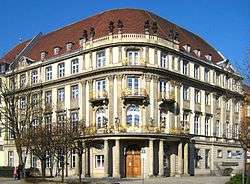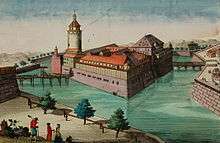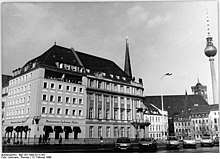Veitel Heine Ephraim
Veitel Heine Ephraim, 1703 – 16 May 1775 in Berlin) was jeweller to the Prussian Court, a silk entrepreneur in Potsdam, the chairman of the Jewish congregation in Berlin/Prussia,[1] and since 1756 Mintmaster in Saxony and from 1758 also in Prussia. During the Seven Years' War Frederick the Great devalued the Prussian coin five times in order to finance the war; debased coins were produced with the help from Ephraim and Daniel Itzig, and spread outside Prussia: in Saxony, Poland, and Kurland.[2][3][4] Ephraim and his companion Itzig became infamous for adding copper, up to 70%, into the fake coins, known as Ephraimiten. The coin fraud of the entrepreneurs became an existential element of war financing. Heinrich Carl von Schimmelmann, Johann Ernst Gotzkowsky and Leendert Pieter de Neufville rivalled Ephraim's exchange business.

Life
Veitel Ephraim was the fifth child of Altona-born jeweller, and elder of the Jewish Community Nathan Veitel Ephraim (1658-1748), who moved from Hamburg to Berlin. His mother came from Vienna. The Ephraim family lived in Spandauer Straße 30. Around 1744/1745 Ephraim became court jeweller of Friedrich II. They had known each other since 1738, when they met at Schloss Rheinsberg. Already as Crown Prince Friedrich was in debt to Ephraim.[5] In 1748 Ephraim leased a factory in Potsdam for lace and had orphans taught in the production of it. In 1750 he was appointed by the King as the senior elder of the Berlin Jewry. In 1752/1754 Ephraim delivered silver to Johann Philipp Graumann director of the Prussian mints.[6][7][8]
Mint activities


After Graumann's fall in early 1755, Veitel Ephraim and his brother-in-law Moses Fränkel leased the Königsberger mint.[9][10] Their success was so great that under similar conditions they were given the lease of the mint of Cleves, where one of Ephraim's sons became in charge on 16 August. In October 1755 he leased the mint facility in Aurich.[11] On 21 November 1756 Ephraim offered the king a seignorage of 20% for leasing the Leipzig mint facility.[12] In Poland, Russia, and Hungary the so-called buyers of entrepreneurs traded the debased coins for the better coins circulating there and delivered them to their clients, Ephraim and Itzig.
They used their extensive business and relational foreign relations to acquire the necessary gold and silver in Holland, especially on the Amsterdam market, in England and in Hamburg by means of Hamburg and Dutch exchange.[13] Another way to raise money was to remelt gold subsidies received from England and to double and triple them by mixing them with other metals.[14]
The revenue from the impact of the coin transactions from 1759 to 1762 exceeded 29 million Thaler and thus, for example, the amount of British subsidies.[15] On 28 January 1764, Frederick the Great Itzig and Ephraim ordered that they invest the great assets they had earned in the Prussian economy.[16] Ephraim left a fortune when he died;[17] he is buried at the Jüdischer Friedhof (Berlin-Mitte).
Personal life
In 1727 Ephraim married to Elke Fraenkel. They had four sons: Ephraim (1729-1803), Joseph (1731-1786), Zacharias (1736-1779) and Benjamin (1742-1811) and two daughters: Edel (1728-1750) and Rosel (1738-1803), who married Heimann Fraenkel (1748-1824). Ephraim's great-granddaughter was Sara Grotthuis, a noted literary salon hostess in Berlin around 1800.
References
- H.B. van der Linden (2013) Veitel Heine Ephraim. Hofjude Friedrichs II. p. 15
- The Berlin Jewish Community: Enlightenment, Family and Crisis, 1770-1830 by Steven M. Lowenstein, p. 26
- Iron Kingdom: The Rise and Downfall of Prussia, 1600-1947 by Christopher Clark
- How Jews Became Germans: The History of Conversion and Assimilation in Berlin by Deborah Hertz
- Schnee, Heinrich, "Ephraim, Veitel" in: Neue Deutsche Biographie 4 (1959), S. 546 f. [Online-Version]; URL: https://www.deutsche-biographie.de/pnd135910331.html#ndbcontent
- Schnee, Heinrich, "Ephraim, Veitel" in: Neue Deutsche Biographie 4 (1959), S. 546 f. [Online-Version]; URL: https://www.deutsche-biographie.de/pnd135910331.html#ndbcontent
- Annalen der Juden in den preußischen Staaten besonders in der Mark Brandenburg, p. 285 von Anton Balthasar König
- Geheimes Staatsarchiv Preußischer Kulturbesitz, Teil I (1999): Ältere ... herausgegeben von Meta Kohnke, Bernd Braun, Manfred Jehle, Andreas Reinke
- B. Kluge (2013) Für das Überleben des Staates, p. 131
- Schrötter, Band III, p. 5
- At some time Friedrich II. ordered that the old and new Louis d'or had to be changed (stamped) into Friedrich d'or in Aurich. The coins could be used by the Prussian East India Company in Asia where it was worth 20% more.
- B. Kluge (2013) Für das Überleben des Staates, p. 132, 134, 135; S. Stern, p. 239
- W.O. Henderson, p. 47
- G. Steiner (1994) Drei preussische Könige und ein Jude. Erkundungen über Benjamin Veitel Ephraim und seine Welt, p. 35
- (PDF) Prekäre Güter: Hofjuden als Heeres- und Münzlieferanten in der Frühen Neuzeit. [accessed Jul 04 2018].
- S. Stern, p. 199
- W.O. Henderson, p. 42
Sources
- Studies in the Economic Policy of Frederick the Great by W.O. Henderson, p. 40
- Forgotten Fragments of the History of an Old Jewish Family by Louis and Henry Fraenkel. Kopenhagen 1975.
- Stern, S. (1950) The Court Jew; a contribution to the history of the period of absolutism in Central Europe. Philadelphia: Jewish Publication Society of America, 1950. Full text online at archive.org